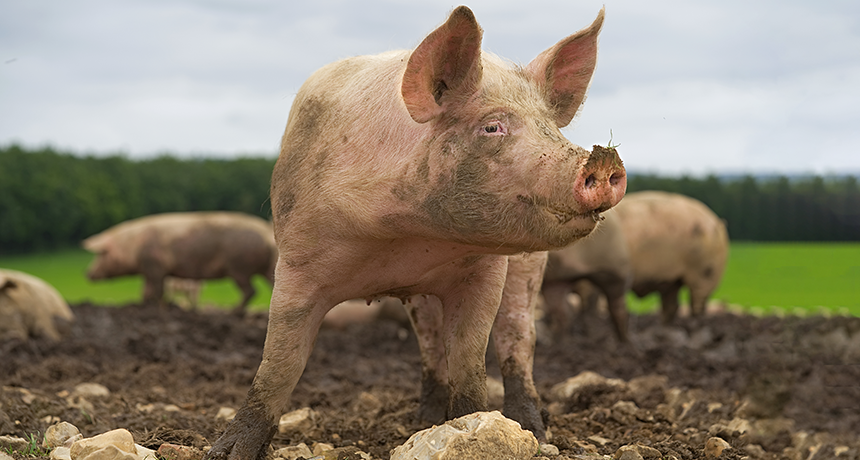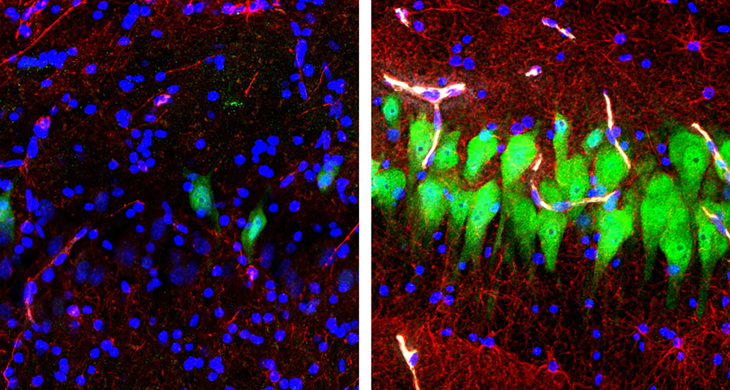In a first, scientists keep cells alive in the brains of dead pigs
This technique might one day lead to better brain therapies for living people

In a feat that has shaken up neuroscience, scientists used an artificial fluid to keep cells alive in the brains of pigs that had been slaughtered for pork.
ChristiLaLiberte/ E+/Getty Images
Scientists have kept cells alive in the brains of dead pigs. This first-of-its-kind feat was done with a sophisticated system of artificial fluid. The pigs had died four hours earlier at a slaughterhouse.
“This is a huge breakthrough,” says Nita Farahany. An ethicist and legal scholar at Duke University in Durham, N.C., Farahany wasn’t involved in the research. “It fundamentally challenges existing beliefs in neuroscience,” she says. The research hints that in some cases, the loss of brain function doesn’t have to be permanent. The findings appeared April 17 in Nature.
In the study, the brains showed no signs of consciousness. For that, they’d need more widespread activity. But individual nerve cells were still firing. “There’s this gray zone between dead animals and living animals,” says Farahany. She coauthored another piece in Nature offered as a commentary on the new study.
The goal was never to create true zombies. Instead, the results may one day lead to better treatments for brain damage. Strokes and other types of injuries can harm brain tissue by starving it of oxygen. The study also raises major ethical questions about research on brains that are neither alive nor yet completely dead.
How to make an undead brain
“No animals died for this study,” the authors of the new work write in their paper. They did the experiments on pigs that had been killed in a food processing plant. These animals were destined to become pork.
Z. Vrselja et al/Nature 2019
After death, the heads of some 300 pigs were put on ice. They they were sent to a lab at Yale University in New Haven, Conn. There, researchers cut out the brains.
Four hours after the animals had died, researchers put 32 of these brains in an artificial system called BrainEx. It includes a fluid designed to stay at the animal’s body temperature and replace its blood. The fluid moves through the blood vessels, carrying oxygen, sugar and other ingredients needed to keep the brain cells fed.
During six hours in the BrainEx system, these dead brains showed signs of activity. Oxygen and sugar went into the brain tissue, and carbon dioxide came out. That suggested some cells in the brains were still alive. Some of the nerve cells in the hippocampus and prefrontal cortex looked healthy under a microscope. These are key brain areas for complex thinking. And studies on brain slices showed that individual nerve cells could still fire off signals. In contrast, brains that weren’t in the BrainEx system broke down over those six hours.
The results suggest that brains are much tougher than once thought. The same thing might even be true of human brains. “That’s the punchline,” says study coauthor Nenad Sestan. He’s a neuroscientist at Yale University. The technique offers a new way to study animal brains in labs, Sestan says. Those experiments might help researchers learn how to treat human brain damage caused by strokes or other injuries.

Ethical puzzles
The study also is notable for what researchers did not see. Electrodes placed on the surface of the brains’ didn’t find coordinated, widespread activity. That sort of activity can indicate some level of awareness. If the scientists had observed such signals, they would have stopped the experiment immediately, says Stephen Latham. He’s a bioethicist at Yale and one of the study’s authors. “It would pose this unique problem of creating some kind of experience or awareness in an organ that’s completely isolated from any living being,” he explains.
In the BrainEx system, the fluid included a compound that blocks brain cell activity. Researchers suspected that too much nerve-cell action would be harmful to the brains. (They removed the blocker when they sliced up the brains to study them more closely — and that’s when they saw activity in the cells.) The scientists don’t know whether removing that blocking compound altogether would have let more complex patterns of brain activity develop. Or maybe such signals would show up after the brains spent more time in the fluid.
The method isn’t close to being ready to use with human brains, the scientists say. Still, this new research raises the possibility that similar approaches might one day restore some function to tissue starved of oxygen in human brains.
Rules for experiments involving living people are strict, Christine Grady said in an April 16 news briefing. She’s a bioethicist at the National Institutes of Health in Bethesda, Md.
But those rules are less strict after death, Grady said. “Once a human dies and their tissue is in a laboratory, there are many fewer restrictions on what can be done.” New abilities to preserve dead tissue will make people think about “whether or not there need to be new rules about how we deal with those tissues,” she says — whether they come from a pig or a person.







